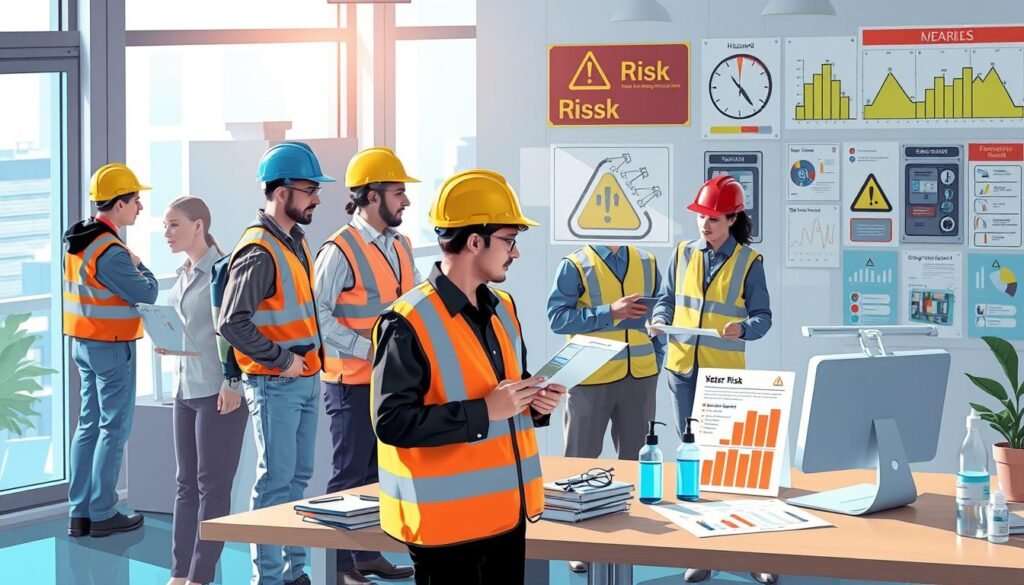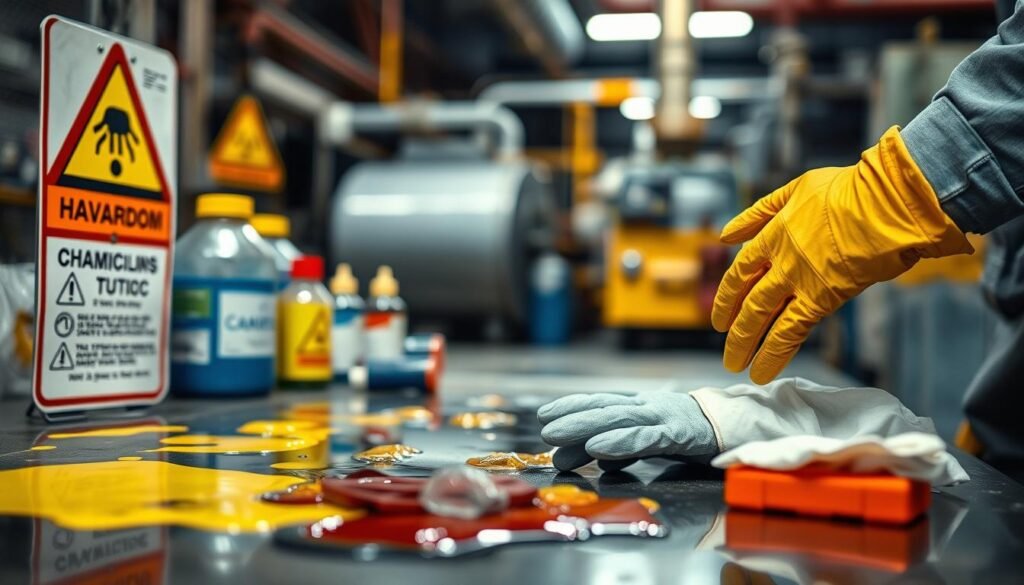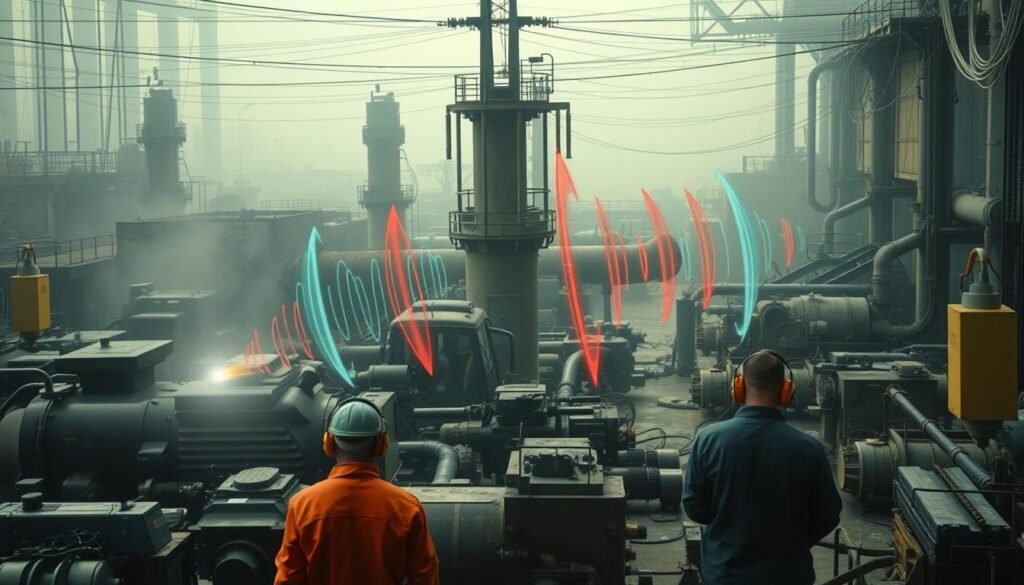Did you know that over 4,500 workplace fatalities occur in the United States each year? This has been the case since 2009. It highlights the need to focus on the dangers people face at work every day. Workers in fields like manufacturing, healthcare, agriculture, and construction come across many risks.
To create a safer work environment, it’s important to know and handle these Environmental and Occupational Risks. Making the workplace safer helps prevent accidents. It also boosts productivity and morale. Occupational Medicine (Occ Med) experts can help companies protect their workers. They do this by setting up safety measures and regular health checks. Knowing the risks in different industries helps improve workplace safety. Learn more about how the environment affects health from the National Institute of Environmental Health Sciences.
The way we talk about keeping workplaces safe is changing. It’s clear that we need thorough plans to reduce danger. Workers and bosses must work together to make sure everyone has a safe and healthy place to work.
Key Takeaways
- Environmental and occupational risks can significantly impact employee safety and health.
- Utilizing OccMed providers helps businesses create safety protocols and manage workplace hazards.
- Regular health screenings can reduce the long-term effects of environmental exposure.
- Manufacturing and construction sites are particularly susceptible to environmental risks.
- Addressing these risks can improve productivity and reduce financial losses for businesses.
- Staying educated about safety regulations and health guidelines is vital for workplace safety.
Understanding Environmental Risks in the Workplace
Environmental risks at work can greatly affect employee health and how well a company does. It’s key to know these risks to keep the workplace safe and healthy. Spotting these dangers early lets bosses make plans to reduce them and keep their teams safe.
Importance of Identifying Environmental Hazards
It’s vital to find environmental hazards because it’s the first step in managing risks. Knowing what dangers are out there means you can act quickly. That way, employees aren’t exposed to harmful stuff. This helps prevent accidents and health problems, saving money and keeping people safe.
Common Types of Environmental Hazards
Different jobs have different environmental risks. Knowing what they are helps in making plans to deal with them. Here are some common hazards:
- Chemical Hazards: These are from toxic chemicals like cleaning stuff, which can make people very sick.
- Physical Hazards: This includes things like too much noise or extreme temperatures that can harm you over time.
- Biological Hazards: Germs and bugs are big risks, especially in hospitals and labs.
- Cultural Hazards: Ways of working that are bad for health or the environment are found in many jobs.
Data from NIOSH shows finding risks early is super important. Groups like OSHA and EPA use this info to make rules that make workplaces safer and healthier. All this shows we must work together to spot and lower risks at work.
| Type of Hazard | Description | Potential Health Effects |
|---|---|---|
| Chemical Hazards | Exposure to harmful chemicals | Respiratory issues, skin disorders |
| Physical Hazards | Noise, radiation, extreme temperatures | Hearing loss, cancer risks |
| Biological Hazards | Bacteria, viruses, fungi | Infections, respiratory diseases |
| Cultural Hazards | Negative workplace behaviors | Stress, mental health issues |
Common Occupational Risks Employees Face
Occupational health hazards are key to workplace safety. Knowing the different health dangers workers face helps companies act to lower risks. This improves worker productivity.
Types of Occupational Health Hazards
OSHA identifies six main types of occupational health hazards:
- Safety hazards: Dangers from unsafe conditions and practices.
- Chemical hazards: Being exposed to harmful substances causing health issues.
- Biological hazards: Risks involving bacteria, viruses, and other pathogens.
- Physical hazards: Things that can harm, like extreme noise or temperatures.
- Ergonomic hazards: Poor workplace ergonomics leading to injuries.
- Work organization hazards: Mental health risks from workplace policies.
These hazards can lead to serious outcomes. For instance, in 2019, over 5,333 fatal work injuries happened in different sectors. Fields like fishing, hunting, logging, and construction saw high dangers. More than 2,100 deaths were due to transportation incidents, showing the need for strong health and safety efforts.
Impact of Occupational Risks on Workforce Productivity
Occupational health hazards hurt workforce productivity. Workplace injuries mean more sick days, skilled workers off the job, and higher health care costs for bosses. For example, slips, trips, and falls made up about 28 percent of injuries in 2019. This highlights the need for safety steps and training.
| Type of Hazard | Examples | Potential Impact on Productivity |
|---|---|---|
| Safety Hazards | Machinery malfunctions, fall risks | Higher injury rates, increased absenteeism |
| Chemical Hazards | Exposure to toxic substances | Long-term health problems, higher worker turnover |
| Ergonomic Hazards | Repetitive motion injuries | Less work efficiency, more health care costs |
Putting occupational health first means a safer workplace. This not only cuts down on health dangers but boosts worker productivity.
Understanding Workplace Safety and Regulations
Workplace safety is key for any business. It greatly affects employee well-being and the company’s performance. OSHA is a federal agency focused on ensuring a safe work environment. It holds companies accountable, protecting workers from harm.
Overview of OSHA Regulations
Since 1971, OSHA has set standards to keep workers safe. These rules help protect against a range of dangers at work. Companies that follow OSHA’s guidelines can improve staff morale and boost productivity.
Importance of Compliance with Safety Standards
Following OSHA rules is critical for many reasons:
- It reduces job-related accidents and injuries.
- It improves worker efficiency by lowering absenteeism due to illnesses or injuries.
- It cuts insurance costs by decreasing accident and claim rates.
- It avoids fines and legal problems from not following the rules.
Employers need to keep their workplaces safe from major hazards. This shows they care about their employees. It also makes for better team relations and a happier workplace.
| Benefit | Description |
|---|---|
| Reduced Workplace Injuries | Good safety practices mean fewer accidents and a safer place to work. |
| Increased Productivity | When employees are healthy, they work better and more efficiently. |
| Cost Savings | Safety efforts save money on accidents, insurance, and legal costs. |
| Enhanced Employee Morale | Secure workplaces make employees feel valued, leading to a positive atmosphere. |
Environmental and Occupational Risks: Key Factors to Consider
It’s vital to understand the complexities of workplace environments. This ensures the safety and health of employees. Analyzing risks means identifying and assessing potential dangers at work. Knowing about these risks helps us find effective solutions. Being aware of both environmental and occupational risks underlines the need for smart choices in various industries.
Identification and Analysis of Risks
To start, we need to systematically understand risks, especially in industrial and urban settings. Health risks often come from using fossil fuels, advances in industry, and pollution. It’s crucial to consider chronic illnesses and specific worker vulnerabilities, especially in riskier sectors.
Strategies for Mitigation
Employers need strong strategies to address workplace dangers. Conducting regular assessments can show if safety protocols need updates. This ensures they meet health standards. Key strategies include:
- Creating safety training programs for workers about dangers.
- Using technologies that cut emissions and better air quality.
- Employing ergonomic designs to reduce strain and injuries.
- Providing mental health support, linking work conditions to mental well-being.
Research led by public health experts helps us see how environment impacts workplace safety. For more details, click here to read about the important link between risk analysis and public health.
| Type of Risk | Example | Mitigation Strategy |
|---|---|---|
| Chemical Hazards | Exposure to toxic substances | Regular monitoring and safety training |
| Physical Hazards | Slips, trips, and falls | Proper signage and maintenance protocols |
| Biological Hazards | Exposure to viruses and bacteria | Hygiene practices and PPE usage |
| Ergonomic Hazards | Repetitive strain injuries | Workstation assessments and adjustments |

Industrial Hygiene Best Practices
Keeping workers safe in different industries is key. Companies need to watch chemical levels and find ergonomic ways to work. Doing this helps employees stay healthy and boosts productivity.
Monitoring Chemical Exposure Levels
Industrial hygienists look out for safety issues with chemicals. They know how to spot dangers in liquids, fumes, or dusts. By keeping an eye on these, they make sure rules are followed and fix problems fast.
This keeps workers from getting sick, like having constant coughs or bad headaches. It’s important for businesses to have good monitoring tools. This way, they ensure everyone’s safety at work.
Implementing Ergonomics in the Workplace
Making workspaces ergonomically safe lowers the chance of injuries, like carpal tunnel or tendonitis. When employers make these changes, everyone works more comfortably and efficiently. Checking for risks lets them fix issues quickly.
This leads to fewer people missing work and less injuries. With better ergonomics, workplaces become healthier. This makes employees happier and more likely to stay on the job.
Recognizing and Managing Toxic Exposures
Toxic exposures are a big problem in many industries, leading to health problems. It’s important to know where these dangers come from. Workers often face risks from chemicals, dust, or biological substances at work, causing serious health issues.
Common Sources of Toxic Exposures in Various Industries
Many industries face specific industry risks leading to toxic exposures. Some of the main sources include:
- Solvents in manufacturing.
- Heavy metals in construction and mining.
- Pesticides and herbicides in farming.
- Asbestos in older construction sites.
- Fumes from welding and other operations.
Understanding these sources can make workplaces safer. Workers, especially in construction and manufacturing, should watch out for heavy metals and solvents. Recent studies show that being aware and taking action can greatly lower the risks from these hazards.
Protective Measures Against Toxic Substances
There are important protective measures employers and workers can take. These actions help keep everyone safe from toxic substances. They include:
- Wearing personal protective gear like gloves and masks.
- Getting trained on how to handle dangerous substances safely.
- Checking exposure levels in the workplace regularly.
- Using engineering controls for better airflow.
- Having clear plans for emergencies with toxic substances.
Taking these steps helps protect workers and makes for a safer workplace. Learning about toxic exposures and following industry guidelines can help avoid bad effects. In the end, dealing with these risks is key for a healthy, safe job site.

Dealing with Air Pollution in the Workplace
Indoor air pollution is a big health risk at work. It comes from things like cleaning products, bad ventilation, and using printers or paints. It’s super important to keep the air clean to keep everyone healthy and working well. Good strategies can really help with these problems.
Sources of Indoor Air Pollution
Workers might run into many bad things in the air that can make them sick and less productive. Major sources of bad air include:
- Volatile Organic Compounds (VOCs): These come from paints, glues, and cleaners.
- Indoor Combustion: This includes smoke from stoves, fireplaces, and others.
- Biological Contaminants: Things like mold, mildew, and dust mites can make breathing hard.
- Pesticides: Bug killing chemicals can stick around in the air.
Effective Air Quality Management Strategies
Making the air at work clean is great for health and helps everyone do their job better. Here are some smart ways to make the workplace safer:
- Improve Ventilation Systems: Make sure the heating, cooling and vent systems work right and use filters to clean the air.
- Regular Air Quality Testing: Test the air for bad stuff like PM2.5 and VOCs. This makes sure the air meets health rules.
- Employee Training: Teach the team about the dangers of air pollution and how to stay safe.
- Periodic Maintenance: Check and fix work equipment regularly to stop harmful particles from getting into the air.
Putting these steps into action can make your workplace much healthier. This lowers the danger from air pollution and helps everybody feel better at work.
Noise Pollution: A Hidden Workplace Hazard
Noise pollution is a big risk at work that many don’t think about much. Being around too much noise can hurt your hearing, make you stressed, and weaken your focus. Knowing how bad noise pollution can be is key to keeping workers happy and productive.
Long-Term Effects of Noise Pollution on Health
Being around noise too much can badly affect your health. Research shows noise pollution causes about 12,000 early deaths a year in Europe. In the U.S., millions suffer from bad noise levels. About 25% of American adults have hearing problems because of environmental noise.
Also, too much noise can make cortisol levels rise, causing anxiety and moodiness. Being near busy roads and hearing traffic all the time can ruin your sleep and even harm your heart.
Measures to Reduce Noise Exposure
Lowering noise at work can boost health and how much gets done. The Health and Safety Executive (HSE) recommends a few ways to do this:
- Using less noisy machines.
- Planning workspaces that block sound naturally.
- Training staff on how to work quietly.
- Checking noise levels often to make sure they’re safe.
Putting in sound barriers and using materials that soak up sound can fight noise pollution. These steps make work a nicer place and help stop the health problems noise can cause.

Creating a Comfortable and Ergonomic Workplace
Today, enhancing productivity and happiness at work means focusing on ergonomic design. Putting comfort first through ergonomic principles cuts down risks and boosts well-being. Let’s dive into the perks of ergonomic design and discuss how to handle common issues.
Benefits of Ergonomic Design
Ergonomic design benefits both staff and companies. The key advantages include:
- Improved workplace comfort boosts employee happiness.
- Better efficiency and productivity with well-arranged workspaces.
- Less chance of injuries, like musculoskeletal disorders.
- Fewer people missing work and lower hiring costs from better retention.
- Financial savings from fewer injuries and healthier workers.
Ergonomic workplace design fits many industries. It shows how important it is to create a healthier work environment.
Common Ergonomic Risks and Solutions
Even with ergonomic efforts, some risks remain. Knowing these helps in preventing and managing them. The usual risks are:
- Bad posture, either sitting or standing, causes discomfort.
- Repetitive strain from actions like typing or lifting.
- Workstations set too high or low, straining muscles and joints.
- Bad environmental conditions that distract and reduce efficiency.
Here are ways to tackle these ergonomic issues:
- Adjustable furniture suits individual needs.
- Regular breaks to ease tension and encourage movement.
- Tools and resources, such as supportive chairs and desks, help a lot.
- Good lighting and air quality keep the workplace pleasant.
Integrating these practices into safety rules helps companies spot and fix ergonomic issues fast. This builds a healthier work culture.
| Ergonomic Risk | Potential Injury | Suggested Solution |
|---|---|---|
| Poor posture | Back pain, neck strain | Adjustable ergonomic chairs |
| Repetitive tasks | Carpal tunnel syndrome | Ergonomic keyboards, regular breaks |
| Improper workstation setup | Muscle fatigue | Proper desk height |
| Poor lighting | Eye strain | Appropriate lighting fixtures |
| Uncomfortable temperatures | Increased absenteeism | Climate control systems |
Investing in ergonomic design shows a company cares for its team. It’s key for a lasting, effective workplace where everyone does their best.
Conclusion
Keeping the workplace safe is key. This means looking out for the health and well-being of employees. Jersey Orias’ thesis shows us how important the history of occupational health systems is. Over 49,000 people die from work-related diseases every year. Both bosses and workers need to spot dangers and make their workplaces safer.
About 5,214 workers died from job injuries in 2008. Climate change is making things worse. It can cause heat stress and make us more likely to get hurt in extreme weather. We need a plan that tackles these issues together. By checking chemical levels and using good ergonomics, we can make places safer and healthier for everyone.
Looking ahead, we must keep making systems and rules better. Paying attention to how climate change affects occupational risks is crucial. This could help stop health problems before they start. For more info, check out the thesis here. By understanding these issues, we can all work towards safer and healthier jobs.